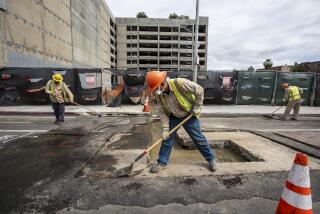A family’s quiet story of determination and success in the city
- Share via
On weekday evenings, a white van circles the neighborhood of Lafayette Park west of downtown Los Angeles. The driver, William Correa, is killing time.
Sometimes, instead of motoring, Correa goes to the library for a couple of hours and reads or watches movies. Other times he goes shopping or has a snack to hold him over until dinner.
At 6:30, the waiting is over. He picks up his two sons at HOLA, or Heart of Los Angeles--a nonprofit after-school program -- and drives them home to Paramount.
Recently I met Juan, the eldest son, a lean and handsome young man of 15. I was on a tour of HOLA when someone introduced us. He was quiet, polite, painfully shy.
Later, I was told that he used to live in the neighborhood and began attending HOLA four or five years ago. Juan got hooked, especially on the art program, and the HOLA staff got hooked on him.
“He’s so quiet, but there’s an intensity,” said Dan McCleary, an accomplished artist who has exhibited extensively and is one of Juan’s teachers at HOLA. “And he’s phenomenal for his age.”
When Juan was about to leave middle school, McCleary suggested he apply to his own alma mater, the private Catholic boys school Loyola High. Juan wasn’t sure he could measure up, or perhaps it was something else that gave him pause.
His parents are Colombian immigrants, and William Correa’s salary as a religious aide at St. Emydius in Lynwood, where he helps parishioners prepare for sacraments, was modest, as was that of his wife, who works as a secretary at the church. Only in a dream could they come up with the tuition to a fine private high school.
McCleary wasn’t about to give up. Though his own art career had been quite successful, he had never felt entirely fulfilled by it. The young energy and talent at HOLA had reawakened something in him, and he was eager to go to bat for Juan.
“I see myself in his quietness,” McCleary said.
McCleary called Loyola to talk up the boy, and he asked the principal to consider a scholarship for him.
It worked, with a catch.
The school didn’t offer a full scholarship. Juan would still have to pay $3,000, and his family still couldn’t cover it. That’s when the staff at HOLA got creative.
HOLA is a place where the kids inspire the adults as much as the reverse. Walk the campus with Tony Brown, the executive director, and he’ll introduce the kid who made it to UCLA, the one who’s on his way to UC Santa Barbara, the guy from Sudan who worked out his problems at HOLA as a kid and volunteers as an adult.
The staff was determined to get Juan into Loyola, so they asked him to hurry up and start drawing and painting, because his work was good enough to sell. Juan does striking, intricate pencil drawings of people, animals and nature scenes. He quickly completed 30 works of art, which were purchased by volunteers, employees and visitors at $100 apiece.
The $3,000 got Juan into Loyola. He’s now in his sophomore year there, and talking about one day trying for Loyola University, or perhaps Stanford, which he visited recently with McCleary for an art show. The idea of becoming an artist burns in him, but knowing it will be tough to make a living that way, he wants to study graphic design too.
“Dan encourages everybody to do their best,” Juan told me late one afternoon in the bright and airy HOLA art studio. “But he helped me a lot, mostly with drawing. He’s an artist, but he’s also a mentor.”
Juan knows, though, that getting to HOLA day after day has created a hardship for his father. Before Loyola, Juan went to school in the Lynwood parish where his father works. His father would drive him to school in the morning, go to work, then drive him to HOLA in the afternoon.
Even after the rent was raised on their apartment and they were forced to move in with relatives in Palmdale, the family wouldn’t give up on HOLA. But it meant leaving home at 4:30 a.m. and getting back to Palmdale at 8 p.m.
The routine was so grueling that they moved last summer to Paramount, which is closer, but still a slog. Mr. Correa drives Juan to Loyola in the morning, goes back to work in Lynwood, then drives his younger son to HOLA in the afternoon and has two or three hours to kill as he waits for both sons.
This kind of sacrifice by parents, McCleary says, is the under-told story of the L.A. inner city, a place where the sensational and the tragic are more likely to make the evening news.
“Juan was living in the middle of gangland,” McCleary said, but he is typical of the many kids from good and decent families. His story is a quiet one, as quiet as Juan himself, and there is no high drama in his father’s daily routine. There is only pride and work and yearning.
On my second visit with Juan, we waited in the parking lot for his father to pull up. Just past 6:30, he appeared. I shook William Correa’s hand and asked him why he endures this grueling daily routine.
“Because my mother and father gave me an opportunity to go to an excellent school in Colombia,” he said. “So I give to Juan and his other brother the same opportunity. I want them to do better than I have.”
More to Read
Sign up for Essential California
The most important California stories and recommendations in your inbox every morning.
You may occasionally receive promotional content from the Los Angeles Times.











